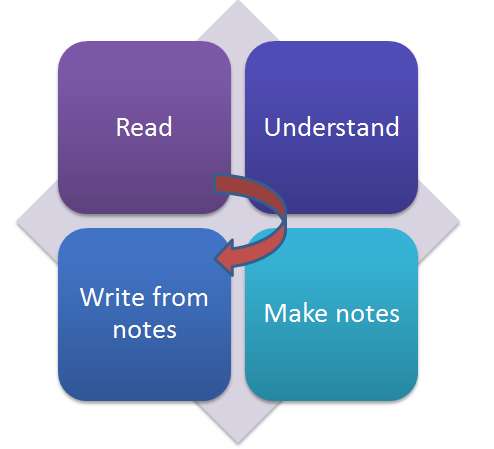
|
SUM2015 Summarising Skills |
The process in action
 Reading and Understanding to Note-making to Writing the Summary
Reading and Understanding to Note-making to Writing the Summary
Work through this process by studying the example below. The purpose is to show that when you practise active reading strategies (reading purposefully and strategically), you can navigate through any text with sufficient control, engagement and understanding.
1) From reading to note-making
Click HERE to view in a new window. Use CTRL+ to enlarge the font and the slide rule at the bottom of the screen window to navigate through the text.
![]() The notes in the Active Reading column (shaded blue) show the reader's engagement with the text. The reader asks questions, separates main points from supporting details or repetition, groups related ideas together, makes decisions to select or skip a particular point, and evaluates the information (Is the information relevant? Is it important?).
The notes in the Active Reading column (shaded blue) show the reader's engagement with the text. The reader asks questions, separates main points from supporting details or repetition, groups related ideas together, makes decisions to select or skip a particular point, and evaluates the information (Is the information relevant? Is it important?).
You can see from the notes that the reader is able to identify three main arguments although the writer appears to make at least six different points. The reader may be misled by the signals given by the writer (i.e. the use of first, second, third), and the writer's organisation of the argument, which begins with the main arguments with supporting detail in the first few paragraphs and then lists the main arguments again in the last few paragraphs (which are mainly one-sentence paragraphs - a feature of newspaper articles). However, by reading critically and actively, the reader is able to follow the writer's arguments, dismiss repetitions, make more accurate notes, and write a concise and accurate summary.
2) From notes to summary writing
Read an example summary and click on the highlighted terms for comments on some stylistic features.
| According to Sipher (1977), public education in America is facing a crisis as evidenced by consistently poor performance of students in standardised tests. Sipher suggests that abolishing compulsory attendance could solve the crisis. He makes three main arguments. First of all, he maintains that this law change would mean that only those young people serious about learning would attend school and their education would not be compromised or hampered by disruptive behaviour. Unlike private schools, public schools cannot expel problem students. With the law change, the profile of public schools as institutions of learning and quality education would also be raised. Sipher argues that grades given to appraise performance would have more credibility and reflect more accurately learning and progress made, resulting in better accountability for failure as early as elementary school. Abolishing the compulsory attendance law would ultimately save schools money, which could be redirected to communities for developing social behaviour changing programmes. Schools could then focus on their primary role of educating young people. |
This is a competent SCALES summary:
- It acknowledges the source.
- It has very good coverage, including all main ideas and relevant supporting ideas.
- It is accurate, retaining the meaning of the original passage.
- It is of an acceptable length, achieved with a concise expression of ideas;
- It uses alternative expressions.
- Its overall style (organisation and use of grammatical items and sentence structure) is quite different from the original text structure. Related arguments are grouped together to improve organisation with appropriate attribution to the source of the ideas. Adequate sign-posting language is used to improve coherence and retain the argumentative tone of the original passage.
Ultimately, an effective summary is both an indication of your understanding of the original ideas and an example of your ability to write in a clear, concise, and communicative academic style. In academic writing contexts, summarising is an essential skill and is one of the most useful ways of incorporating other people's research into your writing.



